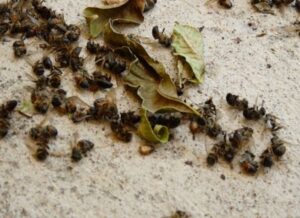Pesticides To Blame For Thousands Of Dead Bees In Minnesota

Last month, three colonies of bees were found twitching and dying on the ground outside hives across the Minneapolis metro area. This week, an investigation confirmed that fipronil, a widely used pesticide, was to blame.
At the time of the massive die-off, Minneapolis residents were both troubled and perplexed by what they saw. Local apiarist Mark Lucas noticed the bees he and his family keeps in their back yard behaving strangely, shaking on the edge of the hive and then falling to the ground. “They just come spilling out of the hive like they’re drunk,” he told Minnesota Daily in mid-September.
Many suspected chemical pesticides were to blame, but they couldn’t be sure. The University of Minnesota Bee Lab and the Minnesota Department of Agriculture (MDA) immediately began testing the affected hives. All tested positive for fipronil.
“Although neonicotinoid pesticides such as clothianidin, thiamethoxam, and imidacloprid have been widely implicated in the phenomenon of colony collapse disorder (CCD), other pesticides are known to adversely affect honey bee health,” states a Beyond Pesticides press release. “Fipronil has also been heavily implicated in elevated bee toxicity and decline. Indeed, the European Union (EU) recently put forth a proposal to restrict the use of the pesticide in recognition of the high acute risks it poses to bees.”
The chemical is most commonly use for indoor and turf pest control in the U.S., and can be found in more than 50 pest-killing products.
Related on Organic Authority:
Save the Bees! 6 Ways To Participate In Honey Bee Awareness Month
EPA Issues Label Advisory For Bee Killing Pesticides
Image: youngandwithit

